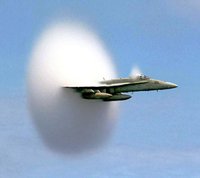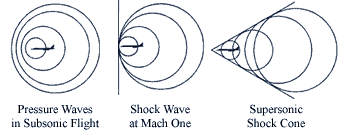Sonic boom
|
|
A sonic boom is the audible component of a shock wave in air. The term is commonly used to refer to the air shocks caused by the supersonic flight of military aircraft or passenger transports such as the Concorde (Mach 2.2, no longer flying) and the Space Shuttle (Mach 27). Sonic booms generate enormous amounts of sound energy, sounding much like an explosion, typically the shock front may approach 100 megawatts per square meter, and may exceed 200 decibels.
| Contents |
Cause of sonic booms
As an object moves through the air it creates a series of pressure waves in front and behind it, similar to the bow and stern waves created by a boat. These waves travel at the speed of sound, and as the speed of the aircraft increases the waves are forced together because they cannot "get out of the way" of each other, eventually merging into a single shock wave at the speed of sound. This critical speed is known as Mach 1 and is approximately 1190 km/h (740 mph) at sea level.
In smooth flight, the shock wave starts at the nose of the aircraft and ends at the tail. There is a sudden rise in pressure at the nose, decreasing steadily to a negative pressure at the tail, where it suddenly returns to normal. This "overpressure profile" is known as the N-wave due to its shape. We experience the "boom" when there is a sudden rise in pressure, so the N-wave causes two booms, one when the initial pressure rise from the nose hits, and another when the tail passes and the pressure suddenly returns to normal. This leads to a distinctive "double boom" from supersonic aircraft. When maneuvering the pressure distribution changes into different forms, with a characteristic U-wave shape. Since the boom is being generated continually as long as the aircraft is supersonic, it traces out a path on the ground following the aircraft's flight path, known as the boom carpet.
A sonic boom can also be caused by high-speed trains in tunnels (e.g. the Japanese Shinkansen). In order to reduce the sonic boom effect on the opposite tunnel a special design of the tunnel exit is necessary. In contrast to the (super)sonic boom of an aircraft, this "tunnel boom" is caused by a rapid change of subsonic flow (due to the sudden narrowing of the surrounding space) rather than by a shock wave, and it has little effect to anything else than the train itself.
Characteristics
The power, or volume, of the shock wave is dependent on the amount of air that is being sped up, and thus the size and weight of the aircraft. As the aircraft increases speed the shocks grow "tighter" around the craft, and do not become much "louder". At very high speeds and altitudes the cone does not intersect the ground, and no boom will be heard. The "length" of the boom from front to back is dependent on the length of the aircraft, although to a factor of 3:2 not 1:1. Longer aircraft therefore "spread out" their booms more than smaller ones, which leads to a less powerful boom.
The nose shockwave compresses and pulls the air along with the aircraft so that the aircraft behind its shockwave sees subsonic airflow.
However, this means that several smaller shock waves can, and usually do, form at other points on the aircraft, primarily any convex points or curves; and especially the inlet to engines. These secondary shockwaves are caused by the subsonic air behind the main shockwave being forced to go supersonic again by the shape of the aircraft (for example due to the air's acceleration over the top of a curved wing).
These shock waves add to the main shockwave at some distance away from the aircraft to create a much more defined N-wave shape. This maximizes both the magnitude and the "rise time" of the shock, which makes it seem louder. On most designs the characteristic distance is about 40,000ft, meaning that below this altitude the sonic boom will be "softer". However the drag at this altitude or below makes supersonic travel particularly inefficient, which poses a serious problem.
Abatement
In the late 1950s when SST designs were being actively pursued it was thought that although the boom would be very large, they could avoid problems by flying higher. This premise was proven false when the North American B-70 Valkyrie started flying and it was found that the boom was a very real problem even at 70,000ft (21,000m). It was during these tests that the N-wave was first characterized.
Richard Seebass and his colleague Albert George at Cornell University studied the problem extensively, and eventually defined a "figure of merit", FM, to characterize the sonic boom levels of different aircraft. FM is proportional to the aircraft weight divided by the three-halves of the aircraft length, FM = W/(3/2·L) = 2W/3L. The lower this value, the less boom the aircraft generates, with figures of about 1 or lower being considered acceptable. Using this calculation they found FM's of about 1.4 for the Concorde, and 1.9 for the Boeing 2707. This eventually doomed most SST projects as public resentment, somewhat blown out of proportion, mixed with politics eventually resulted in laws that made any such aircraft impractical (flying only over water for instance).
Seebass-George also worked on the problem from another angle, examining ways to reduce the "peaks" of the N-wave and therefore smooth out the shock into something less annoying. Their theory suggested that body shaping might be able to use the secondary shocks to either "spread out" the N-wave, or interfere with each other to the same end. Ideally this would raise the characteristic altitude from 40,000ft to 60,000, which is where most SST designs fly. The design required some fairly sophisticated shaping in order to achieve the dual needs of reducing the shock and still leaving an aerodynamically efficient shape, and therefore had to wait for the advent of computer-aided design before being able to be built.
This remained untested for decades, until DARPA started the Quiet Supersonic Platform project and funded the Shaped Sonic Boom Demonstration aircraft to test it. SSBD used a F-5 Freedom Fighter modified with a new body shape, and was tested over a two year period in what has become the most extensive study on the sonic boom to date. After measuring the 1,300 recordings, some taken inside the shock wave by a chase plane, the SSBD demonstrated a reduction in boom by about one-third. Although one-third is not a huge reduction, it could reduce the Concorde below the FM = 1 limit for instance.
There are theoretical designs that do not appear to create sonic booms at all, such as the Busemann's Biplane. Nobody has been able to suggest a practical implementation of this concept, as yet.
Hearing sonic booms
The sound of a sonic boom depends largely on the distance between the observer and the aircraft producing the sonic boom. A sonic boom is usually heard as a deep double "boom" as the aircraft is usually some distance away. However, as those who have witnessed landings of space shuttles have heard, when the aircraft is nearby the sonic boom is a sharper "bang" or "crack". The sound is much like the "aerial bombs" used at firework displays.
Media
These videos include jets achieving supersonic speeds.
Template:Multi-video start Template:Multi-video item Template:Multi-video item Template:Multi-video item Template:Multi-video item Template:Multi-video end
See also
External links
- NASA opens new chapter in supersonic flight (http://spaceflightnow.com/news/n0309/06supersonic/)
- "Sonic Boom (http://fluidmech.net/tutorials/sonic/sonicboom.htm)," a tutorial from the "Sonic Boom, Sound Barrier, and Condensation Clouds (http://fluidmech.net/tutorials/sonic/sonicboom-intro.htm)" (or "Sonic Boom, Sound Barrier, and Prandtl-Glauert Condensation Clouds") collection of tutorials by Mark S. Cramer, Ph.D. at http://FluidMech.net (Tutorials, Sound Barrier).


